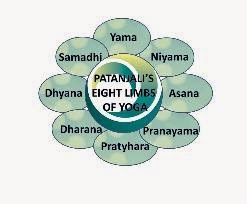8 Reasons to Practice Yogic Breathing (Pranayama)

Yogic breathing or Pranayama refers to ‘Prana’ (energy, breath or life force) and ‘ayama’ or expansion of this energy and awareness. This implies that pranayama aids in the expansion of one’s consciousness beyond previous limits of the conditioned mind. It allows us to think outside of the box.
We know that breathing is the primary function required to sustain life, yet we somehow seem to miss this in the whirlwind storm of daily traffic, family life, health issues and so forth. How often do we stop to notice the patterns and flow of breath during our working day?
Classical Hatha Yoga has been codified and divided into 8 distinct limbs and pranayama has been considered by many to be the crucial limb which helps bind this yogic wheel. It greatly improves circulation and therefore physical, mental and emotional well being. Let’s fall in to this ancient code to see our 8 reasons revealed like a magical formula.
1 Social and 2 Personal Ethics – are developed through yogic practice. All that we think and feel relates to our breathing. We see this to be true when we observe breathing patterns under different circumstances. When angry, sad, depressed, anxious or fearful; all of these will manifest slightly different breathing patterns which demonstrate the underlying mental and emotional imbalances by way of a concurrent physical imbalance as opposed to a complete, smooth and seemingly effortless breath. When our breath is calm and deep our mind becomes clear, enabling us to see our deepest recesses and choose right conduct, such as ‘non violence’ and ‘contentment’ over violence (like ‘aggressive horn blowing’) and constant craving for sensory pleausres.
3 Postures – when we practice yogic breathing regularly it greatly enhances our core awareness, increasing strength and mobility in the physical core (pelvic floor, abdomen and spine) which naturally correspond to our mental and emotional core counterparts. If we walk/sit tall, we feel alert and confident. When the spine is well aligned and balanced, deep and natural breathing return to us and this allows the brain to receive a plentiful supply of oxygen to keep the body happy in life’s symbiotic dance.
4. The fourth limb is pranayama itself. Let’s assume the old saying ‘take a breath and count to 10’ and see how much weight this carries. Of course the saying comes from the experience that pausing during breathing creates; what the Quantum Physicist calls SpaceTime. When stressed we feel compressed and unable to fathom how to cope and meet demands. Then after a few minutes of breathing and pausing we see the world with renewed perspective as the conscious breathing brings us in to the present moment. We know that we can only do one thing at a time and see clearly which task is most pressing, dealing with it calmly. By maintaining this awareness of regulated breathing we are able to preserve focus for extended periods of time, often way beyond our previous norm.
5. Sense Withdrawal is the 5th limb and this is where sustained awareness of breathing enables us to further withdraw our attention away from our 5 senses and the disturbances of the buzzing world back in to our core so that we can remain centred at all times. By preserving our nervous energy which we so easily lose through our 5 senses, we maintain sufficient energy to see that we are the ‘eye’ of the storm, our own centre of gravity, attracting to us all that we need when we really need it.
6. Concentration follows as the next limb. It is a given that if we maintain a constant flow of breath for extended periods of time we will develop a laser-beam-like-mind. To put this another way, when we start to practice breathing techniques, we often see that our body, breath, senses and mind are all erratic and dispersed and that although we think we are sharp, our ability to hold the thread of attention is actually quite poor. To succeed at anything in this life, we need to concentrate and maintain our focus of intention with attention.
Meditation and Absorption are the 7th and 8thbenefits of regular yogic breathing practice. To meditate is where ‘you disappear in to the music’ and to prolong this ability to meditate eventually leads one to final freedom or Absorption. The practitioner becomes fear free, ever joyful and sees themself as one with all existence.
Breathe
A breath at a time.
Breath after breath
And moment by moment
Enjoy.
Matt Gluck – Pranasana Yoga – 7th January 2015
